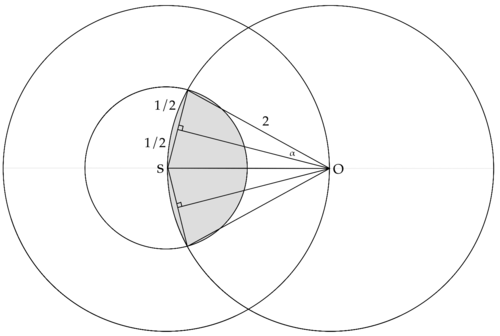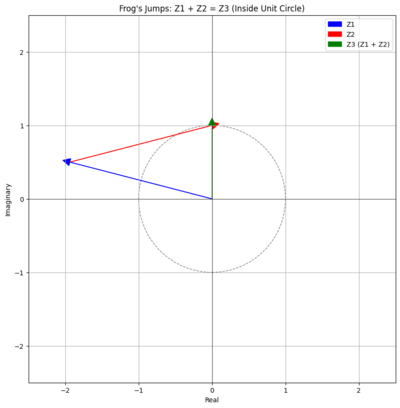2023 AMC 12B Problems/Problem 20
Contents
[hide]Problem
Cyrus the frog jumps ![]() units in a direction, then
units in a direction, then ![]() more in another direction. What is the probability that he lands less than
more in another direction. What is the probability that he lands less than ![]() unit away from his starting position?
unit away from his starting position?
![]()
Solution 1
Let Cyrus's starting position be ![]() . WLOG, let the place Cyrus lands at for his first jump be
. WLOG, let the place Cyrus lands at for his first jump be ![]() . From
. From ![]() , Cyrus can reach all the points on
, Cyrus can reach all the points on ![]() . The probability that Cyrus will land less than
. The probability that Cyrus will land less than ![]() unit away from
unit away from ![]() is
is ![]() .
.
![]()
Therefore, the answer is
![\[\frac{4 \arcsin \frac14 }{ 2 \pi} = \boxed{\textbf{(E) } \frac{2 \arcsin \frac{1}{4}}{\pi}}\]](http://latex.artofproblemsolving.com/2/f/3/2f31034de76a6ae51c2ee32e928e18e2bba70d95.png)
Solution 2
Denote by ![]() the position after the
the position after the ![]() th jump.
Thus, to fall into the region centered at
th jump.
Thus, to fall into the region centered at ![]() and with radius 1,
and with radius 1, ![]() .
.
Therefore, the probability is
![\[ \frac{2 \cdot 2 \arcsin \frac{1}{4}}{2 \pi} = \boxed{\textbf{(E) } \frac{2 \arcsin \frac{1}{4}}{\pi}}. \]](http://latex.artofproblemsolving.com/6/e/d/6edb5c671433291b14a0e16f099947181f8a4717.png)
~Steven Chen (Professor Chen Education Palace, www.professorchenedu.com)
Solution 3(coord bash)
Let the orgin be the starting point of frog. Then, WLOG assume that after the first jump, it is at the point (2,0). Then, the range of all possible places the frog can jump to at its second jump is the circle with equation ![]() .If it landed
.If it landed ![]() unit within its starting point (the orgin), then it is inside the circle
unit within its starting point (the orgin), then it is inside the circle ![]() . We clearly want the intersection point. So we're trying to solve the system of equations
. We clearly want the intersection point. So we're trying to solve the system of equations ![]() and
and ![]() . We have
. We have ![]() , so
, so ![]() . Therefore, our desired answer would be
. Therefore, our desired answer would be ![]() (the angle we want divided by
(the angle we want divided by ![]() ). Since
). Since
![]()
where the last step holds by the double angle formula, our answer is  .
~Ddk001
.
~Ddk001
Solution 4 - Law of Cosines and Double Angle Formula
Let ![]() be Cyrus's starting point,
be Cyrus's starting point, ![]() be the first point he jumps to (
be the first point he jumps to (![]() ), and
), and ![]() be the second point he jumps to (
be the second point he jumps to (![]() ). Let angle
). Let angle ![]() be
be ![]() , such that
, such that ![]() . The probability of
. The probability of ![]() would therefore be
would therefore be ![]() (since
(since ![]() could be on either side of
could be on either side of ![]() so there are two possible areas of having
so there are two possible areas of having ![]() ) which simplifies to
) which simplifies to ![]() . Converting to radians gives us
. Converting to radians gives us ![]() . To find
. To find ![]() , we use the law of cosines.
, we use the law of cosines.
![]()
![]()
![]()
![]()
![]()
![\[k = \arccos\left(\frac{7}{8}\right) = \arcsin\left(\sqrt{1 - \left(\frac{7}{8}\right)^2}\right) = \arcsin\left(\sqrt{\frac{15}{64}}\right) = \arcsin\left(\frac{1}{4} \sqrt{\frac{15}{4}}\right) = \arcsin\left(\frac{1}{4} \sqrt{1 - \left(\frac{1}{4}\right)^2}\right)\]](http://latex.artofproblemsolving.com/a/5/c/a5cfa55aa41aa6bc92c77d2eab04529367925d02.png)
![]()
The probability is ![]()
which is ![]() .
.
Solution 5 - Complex Number and Double Angle Formula
The frog jumps 2 units in one direction, which we can represent as ![]() , where
, where ![]() is the angle in radians. Then, the frog jumps another 2 units in a different direction, represented as
is the angle in radians. Then, the frog jumps another 2 units in a different direction, represented as ![]() , where
, where ![]() is the angle in radians.
is the angle in radians.
The total displacement from the starting position is ![]() .
.
We need to find the condition under which ![]() . This translates to:
. This translates to:
![]()
![]()
![]()
![]()
The magnitude squared of this sum is:
![]()
![]()
![]()
![]()
Thus:
![]()
![]()
![]()
Therefore, our desired answer would be ![]() (the angle we want divided by
(the angle we want divided by ![]() ). Since
). Since
![]()
where the last step holds by the double angle formula, our answer is  .
.
Video Solution 1 by OmegaLearn
Video Solution
~Steven Chen (Professor Chen Education Palace, www.professorchenedu.com)
See Also
| 2023 AMC 12B (Problems • Answer Key • Resources) | |
| Preceded by Problem 19 |
Followed by Problem 21 |
| 1 • 2 • 3 • 4 • 5 • 6 • 7 • 8 • 9 • 10 • 11 • 12 • 13 • 14 • 15 • 16 • 17 • 18 • 19 • 20 • 21 • 22 • 23 • 24 • 25 | |
| All AMC 12 Problems and Solutions | |
The problems on this page are copyrighted by the Mathematical Association of America's American Mathematics Competitions. ![]()











